Ever Ready Radios
The Early Years and Lissen
Britain was slow to electrify and many of the
rural areas remained without electricity for a long time. Due to this
there was a large battery market and for many years large numbers of
radio batteries were sold. In 1934 the sales of high tension radio
batteries exceeded 15 million. The Ever Ready Company (Great Britain)
Limited was the market leader and was part of an international group
that originated in America at the turn of the century. It was
incorporated in Canada in 1932 and the British company held quite a
number of the shares.
|

|
|
The History of Radio |
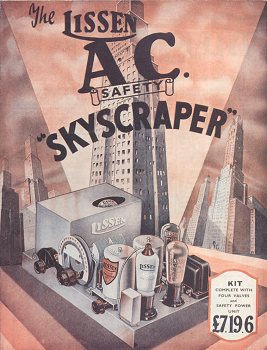 |
In 1928 Ever Ready purchased Lissen Limited from
its owner and Managing Director, T. N. Cole, for over 1 million
pounds. Thomas Noah Cole was born in 1891 at Llanllwni, near
Lampeter and brought up in Cardiff. He was interested in
football and a keen supporter of the Cardiff team. His father
was a marine engineer and Thomas's first job was selling bananas
from a hand cart.
In the early 1920's there was a lot of
interest in radio and he realised that there would soon be a
large market for radio components. With this in mind he moved to
London and set up the Lissen Company.
In 1923 he formed Lissen
Limited, with works at Shepherd's Bush, to sell a large range of
components, most of which were made at the factory. Thomas's
wife Rebecca was the main shareholder and the company was very
successful, employing around 3,000 people by the mid 1920's. |
|
The company had three factories, one produced batteries and the other two
produced components. The company sold everything that was required to build a
radio. There were Lissen valves, resistors, capacitors, coils, transformers,
loudspeakers and cabinets.
Lissen also produced a range of complete radio kits
under the name of Skyscraper, and published plans which encouraged builders to
solely use Lissen components, suggesting that to do so would produce a receiver
of superior quality. Ever Ready continued producing Lissen components and radios
until the beginning of the second world war, after which the Lissen name ceased
to be used. |
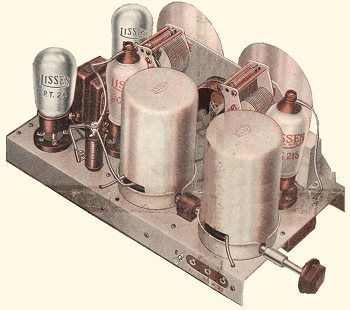
The Lissen Skyscraper 4. |
|
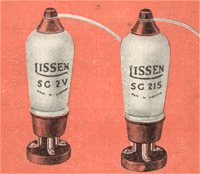 |
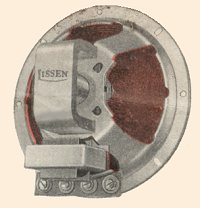 |
A Lissen moving coil
loudspeaker from the early 1930's. |
|
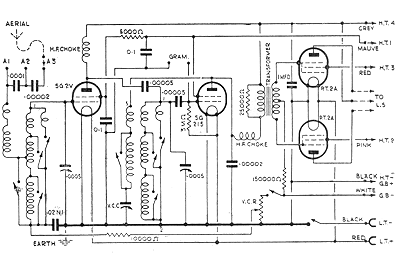
The circuit diagram of the Lissen
Skyscraper 4.
|
When Ever Ready purchased the company, part of the
deal was that Thomas Cole would remain as Managing Director, but
for 10 years he would not get involved in any business venture
that would be in direct competition with Lissen Limited.
Eventually he would come to regret not being his own master, and
in 1934 purchased the ailing Burndept radio company and founded
a new battery company called Vidor. |
Vidor was named after the initials of Thomas's two daughters, Valerie and
Denise, and his Wife Rebecca. As a concession to Ever Ready and his agreement
with the company, he did not run Burndept and Vidor himself, but employed Mr.
R.P. Richardson as Managing Director. In 1935 Thomas brought an action appealing
against the agreement and engaged Sir Stafford Cripps, and two other eminent
lawyers. On the eve of the action, an out of court settlement was made and from
that time on, relations between Ever Ready and Vidor were strained. This wasn't
helped by the fact that Vidor batteries were popular with radio dealers, because
the company offered a 25 percent discount and the batteries sold at a very
competitive price.

The Move to Wolverhampton
|
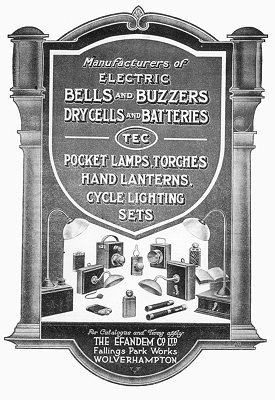
An Efandem Co. Ltd. advert from 1920. |
In 1911 the Efandem Company Limited moved from Birmingham
to new premises at Park Lane. The strange name Efandem (F & M )
came from the initials of the two directors.
The company produced a wide
range of electrical goods including batteries, torches, hand lanterns,
searchlights, sirens, car and bicycle lighting sets, hand lamps, torch
cases, bells, buzzers, and friction clutches for machinery. |
| A photograph of the Efandem staff in
1913. |
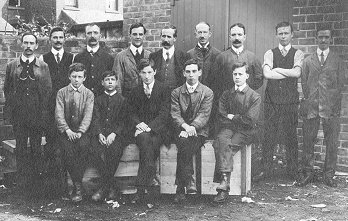 |
|
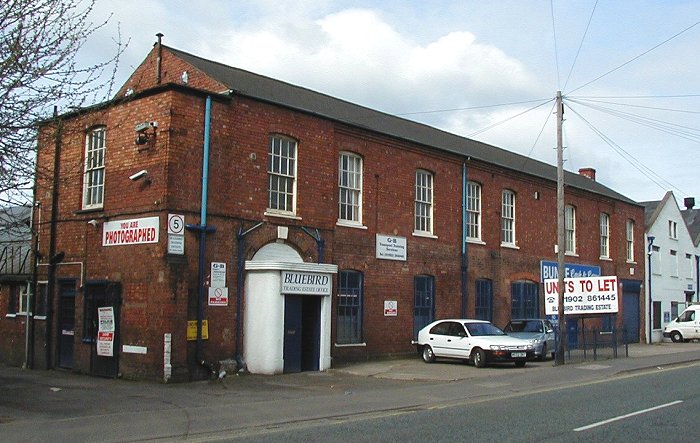
The front of the Ever Ready factory in Park
Lane, in 2001. Most of the building has since been demolished. |
| During the first world war production was concentrated on
the war effort and the items produced included torches, torch batteries,
searchlights and sirens. After the war the company was in a poor
financial state and the Managing Director was convicted for embezzling
several thousand pounds.
As luck would have it, Ever Ready was
interested in the factory and purchased the company in the mid 1920s. The works went on to employ nearly 3,000 people and produced large
numbers of dry batteries and radio receivers. |
|
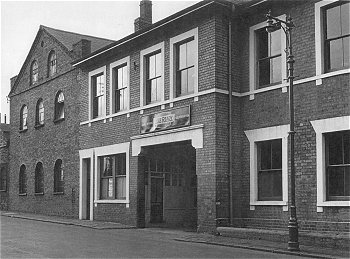
Ever Ready's Canal Works in Lower Walsall Street.
photo courtesy of Trevor Ridgeway. |
A few years later, motorcycle and vehicle manufacturer,
A.J.S., went into liquidation and the company's Lower Walsall Street
Works were put onto the market.
The works were sold to Ever Ready on
25th January 1932, for £12,750, and went on to become an important
centre for the manufacture of torches. The works became known as Canal
Works. |
The Radio Era
Ever Ready's commercial policy was to encourage the use and production of
battery powered equipment, and with this in mind the company entered the radio
manufacturing business. The first two Ever Ready receivers appeared at the
beginning of 1935 and strangely one of them was mains powered. Initially Ever
Ready collaborated with Pye and Mr. Charles Orr Stanley who owned Pye, was
invited onto Ever Ready's Board as a non-executive director. The chassis and
cabinets were made by Pye and put-together at Ever Ready's Finsbury Park
factory, which was supervised by Pye management. The collaboration only lasted
for a few years. Just before the war Charles Stanley fell out with Magnus
Goodfellow, who was Ever Ready's Chairman, and the venture came to an end.
|
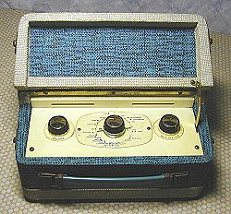 |
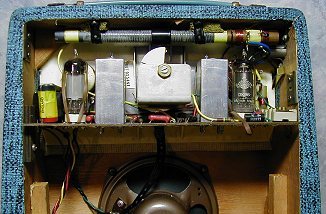
|
|
The Sky Baronet valve portable. |
The Lissen factory at Islington was still in production and at the beginning
of the second world war it obtained a ministry contract to assemble and repair
"Comfort Sets" for the armed forces. All went well until 1941, when the factory
was destroyed in an air raid. The company was tied to the ministry contract and
so it was essential to quickly find new premises, and continue production.
Initially manufacturing began again at Amersham, Buckinghamshire, but the
buildings were too small and unsuitable for this kind of use. Space was found at
Canal Works and in 1942 Ever Ready began to build radios in Wolverhampton. More
space was still required and so the radio department soon made its final move to
Block 'A' of the Park Lane works.
| Although the radio department was situated in a part of
the battery works, it operated as a separate unit and reported directly
to the company's Board of Directors. After the war, the department began
to produce radios for the civilian market, and all future Ever Ready
radios were designed and built here, except for the Type 'B' of 1947,
which was built by Plessey.
The first receiver to be produced after the
war was the Model 'A', which was a development of the wartime "Comfort
Set". It was a heavy 4 valve superhet in a wooden case with a crackle
paint finish. The controls and carrying handle were on the top, and it
was powered by a B103 battery. |
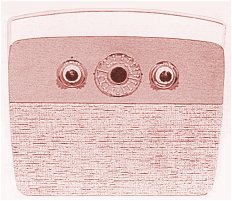
The Sky Captain. |
The next model produced here was the Model 'C', which was still as heavy as
the Model 'A', but had a more elegant appearance. One notable early receiver was
the 'J' Type or "Saucepan Special" which was launched in September 1949.
Laurence Orchard was one of the company's senior executives. In 1948 he was on a
visit to Ever Ready's South African subsidiary, BEREC ( the British Ever Ready
Export Company).
|
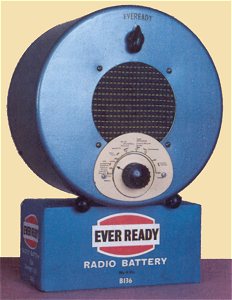
The Saucepan Special. |
While there he was approached by the man in charge of
broadcasting in Nyasaland and Rhodesia. He wondered if Ever Ready could
produce a tropicalised dry-battery radio that could sell for £5, as this
was all that many members of the rural community could afford. The
company rose to the challenge and developed a small 4 valve shortwave
receiver that was powered by a B136 battery.
One problem was to find a
cheap housing for the receiver. This was cleverly solved by using a
blue-sprayed metal case that was made by the British Aluminium saucepan
factory. It was basically a 10inch saucepan with the handle removed and
a hole punched in the bottom for the loudspeaker. The radio sat on the
B136 battery, which was too big to fit inside. The radio was sold in
many parts of the world, including Malasia, and almost a quarter of a
million were produced. |
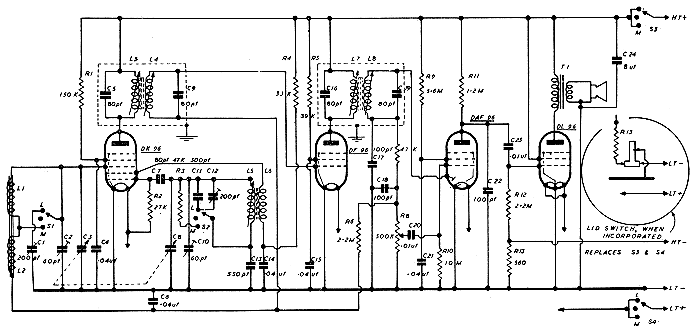
The circuit diagram of the Berec 'Ballerina'.
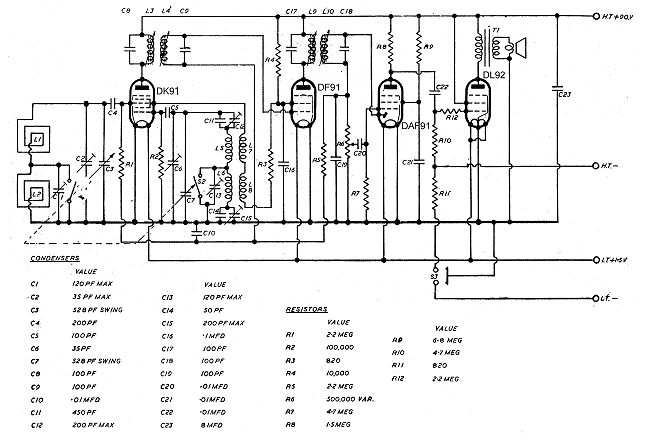
The circuit diagram of the type 'N' from 1951.
The 'J' Type was followed by the 'K' Type and then the 'N' Type, after which
the company began to use the word 'Sky' in most of the names of new receivers.
This came from the old Lissen days when Lissen produced its successful range of
Skyscraper receivers. In 1957 the company produced the Sky Leader, which
was Ever Ready's first transistorised receiver. The company's last valve
receiver was the Sky Captain of 1961. The radios were very successful and
production peaked at about 5,000 receivers per week. The factory produced over 1
million radios.
|
|
|
Early Receivers
Produced in London |
| Model |
Year |
Valves |
| 5007 |
1935 |
K80A, K50M, K23B, K77A |
| 5008 |
1935 |
TP2620, VP1321, PENDD4020 |
| 5012, 5024, 6012 |
1936 |
K50M, K30D, K70B |
| 5016 |
1936 |
A50P, A50B, A70D, A11D |
| 5027 |
1937 |
A50P, A30D, A70D, A11B |
| 5028, 8122 |
1937 |
K50M, K30D, K70B |
| 5029, 5040 |
1937 |
A36B, A50P, A23A, A70D,
A11D |
| 5032 |
1937 |
K80B, K50N, K23B, K70B |
| 5038 |
1937 |
A80A, A50P, A27D, A11D |
| 5010 |
1938 |
K50M, K30K, K30K, K70D |
| 5010, 5118 |
1938 |
K80B, K50N, K23B, K70B |
| 5041 |
1938 |
K50N, K30K, K30K, K70B |
| 5103, 5117 |
1938 |
A36B, A50P, A23A, A70D,
A11D |
| 5203 |
1939 |
ECH3, EF9, EBC3, EL3, AZ1 |
| 5214, 5215, 5216, 5217, 5218, 5219, 5318 |
1939 |
DK1, DF1, DAC1, DL2 |
| |
|
Valve Receivers
Produced at Wolverhampton |
| Model |
Year |
Valves |
| Model 'A' |
1945 |
DK32, DF33, DAC32, DL35 |
| Model 'C' |
|
DK32, DF33, DAC32, DL35 |
| Model 'H' |
|
|
Model 'J' - "Saucepan
Special" |
1949 |
|
| Model 'K' |
|
DK91, DF91, DAF91, DL92 |
| Model 'N' |
|
DK91, DF91, DAF91, DL92 |
| Sky Queen T K |
|
DK91, DF91, DAF91, DL92 |
| Sky Queen |
1953 |
DK96, DF96, DAF96, DL96 |
| Sky Prince |
1954 |
DK96, DF96, DAF96, DL96 |
| Briefcase N3 |
1955 |
DK96, DF96, DAF96, DL96 |
| Sky Monarch |
1955 |
DK96, DF96, DAF96(2),
DL96(2), DM70 |
| Sky Monarch (AM / FM) |
1955 |
DF97, DK96, DF96(3),
DAF96(2), DL96, DM70 |
| Sky Monarch (AM / FM) |
1956 |
DF97, DF96(4), DAF96(2),
DL96(2), DM70 |
| Sky Baby |
1956 |
DK96, DF96, DAF96, DL96 |
| Sky King |
1956 |
DK96, DF96, DAF96, DL96 |
| Sky Princess |
1956 |
DK96, DF96, DAF96, DL96 |
| Sky Lord |
1957 |
DK96, DF95, DAF96, DL96 |
| Sky Casket |
1958 |
DK96, DF96, DAF96, DL96 |
| Sky Emperor |
1958 |
DF97(4), DK92, DAF96,
DL96(2), DM70 |
| Sky Queen 2 |
1959 |
DK96, DF96, DAF96, DL96 |
| Sky Baronet /Countess |
1959 |
DK96, DF96, DAF96, DL96 |
| Skyscraper L26 |
|
DK92, DF96(2), DAF91, DL94 |
| Sky Captain |
1961 |
DK96, DF96, DAF96, DL96 |
| |
|
Transistor Radios |
| Model |
Year |
Transistors |
| Sky Leader |
1957 |
OC44, OC45(2), OC78(3) |
| Sky Leader |
1957 |
OC44, OC45(2), OC71,
OC72(2) |
| Sky Personal |
1959 |
XA102, XA101(2), XB113,
XC121(2) |
| Sky Personal |
1959 |
XA102, XA101(2), OC71,
OC72(2) |
| Sky Baron |
1960 |
XA102, XA101(2), XB113,
XC131(2) |
| Car Portable |
1960 |
OC44, OC45(2), OC82(3) |
| Sky Lark |
1963 |
OC44, OC45(2), OC81D,
OC81(2) |
| Sky Master |
1963 |
AF117(3), OC81D, OC81(2) |
| Sky Tourer |
1964 |
|
| De-Luxe Receiver |
|
|
| |
|
Some of the Berec
Receivers |
|
Berec Ballerina |
| Berec Brigand |
|
|
| Berec Commander |
|
|
| Berec Demon |
|
|
| |
|
|
|
The Radio Department
Everyone in the department worked closely with other members of the team and
helped to maintain the quality of the products. A family-business atmosphere
prevailed and everyone enjoyed their time at Ever Ready.
The management team was as follows:
| Freddy Hillman |
Factory Manager |
| Tom Harrison |
Production Manager |
| George Webster |
Chief Inspector |
| Roland Williams |
Quality Control and Test |
| Bob Lampitt |
Chief Engineer |
| Tom Poulton |
Assistant Factory Manager |
| New products were designed by Bob Lampitt and his team of
engineers and designers. Prototype receivers were subjected to a
critical analysis to determine the best method of assembly. Tom Harrison
(Harry), and Roland Williams and his team, decided what sections were to
be made as sub-assemblies, and what metal pressings were required.
They
also decided on the coils and transformers that would be produced in the
coil winding section, tag boards, battery and loudspeaker leads, silk
screening artwork, for printed items, case covering, and a thousand and
one other things. |
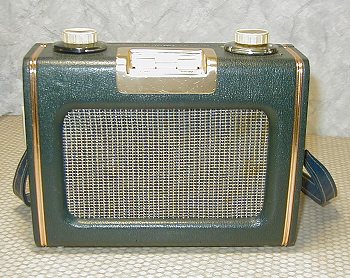
The Sky Master. |
A pre-production batch of six or more receivers were assembled by a select
group, who in co-operation with the drawing office and laboratory, carried the
new model into production. These receivers were used to prove the design,
establish quality standards, test procedures, and timings to determine the "rate
for the job". Once finalised, the assembly of large quantities followed, along
with test, packing and despatch.
|
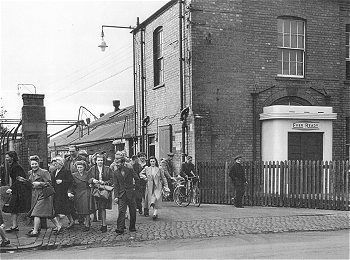
The end of a day's work.
photo courtesy of Trevor Ridgeway. |
The Ever Ready Van Sales force distributed many of the
finished products to radio shops, outlets selling batteries, general
stores and cycle shops.
Large quantities of receivers were distributed
by BEREC and others were sold to mail order companies and Wireless for
the Blind. |
By 1968 it was all over. Ever Ready decided to close the radio department and
concentrate solely on battery manufacture at Park Lane. Just before closure the
team designed and produced a prototype portable television receiver that ran on
dry batteries. It used electrostatic deflection to reduce power consumption and
was far ahead of its time.
Battery production continued at Park Lane until the spring of 1980, when the
works finally closed. Demand for the company's products had slowly been falling
and the works were no longer profitable.
I would like to thank Trevor Ridgeway and his wife, for all of their help in
producing this section.
|

|
|
Return to the List
of Manufacturers |
|